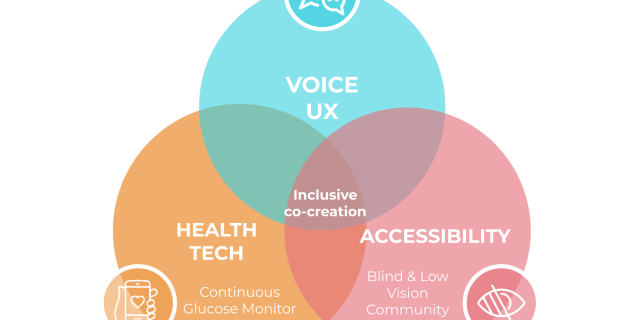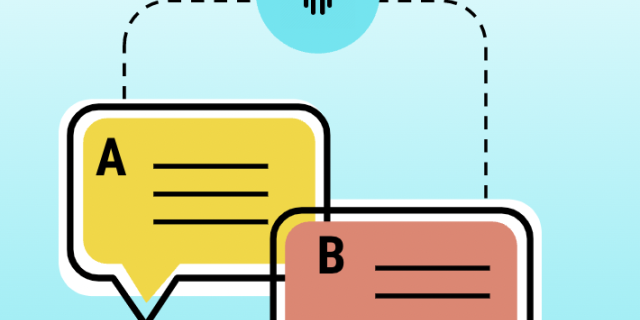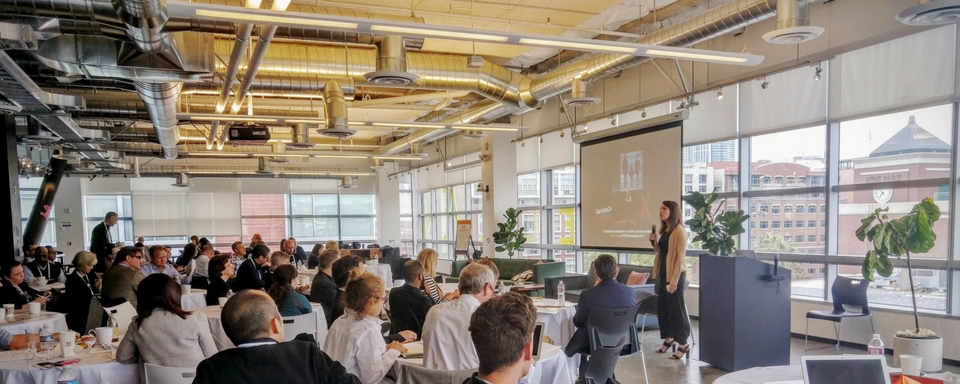I managed to pin down our new Director of Insights and Service Design, Mary Piontkowski, to find out a little more about her. This is what I discovered.
Welcome! You seem so enthusiastic about the work you do. Can you give us a brief background as a professional in the field, and how it relates to the work you are doing now?
I absolutely love what I do. And I tell people every time I speak that they should too, or else they should get another job. Life is too short and we work too much to have it any other way. But seriously, the work we do, studying human behavior and then helping our clients design accordingly, is such satisfying work. Both an art and a science. I studied math and design. This is perfect.
I have practiced design in the Bay Area for close to 20 years now, with a short stint in London. I’ve always believed that designers should practice qualitative research to be empowered to find their own answers to design questions. I’ve worked with and built several teams at Organic, Adaptive Path, Macadamian and EY-Seren, prior to gotoresearch.
Throughout my career, we (designers) struggled in the Bay Area to convince our clients that our design methods would help them do more than create an app or a part of an experience. Over time things have shifted. In Europe, Service Design has been widely accepted and clients expect that agencies would use design thinking techniques to help them innovate. Now in the U.S., and in the Bay Area where it’s been harder with so many tech-focused companies, clients are seeing the value in taking a design and user-centric approach to solving business problems. In fact, so much so that companies are shifting their cultures and building teams internally to do the same. It’s such an exciting time in our industry now that we’ve worked through some real-world case studies that prove there is no other choice for businesses to succeed.
The term, Service Design is less known in the United States but seems to be catching on.
Can you help me define what Service Design is, as a profession, a discipline, or an industry?
Service Design is about creating outstanding experiences, end-to-end and at every touchpoint. It requires deep customer insights to inform a vision of something that will stick. It requires a client and culture accepting of this and realizing that all business units must work together and be open to changing together. It’s about helping our clients discover the right solutions for their customers and for their own organizational design through research, co-creation and other design thinking techniques.
Service Design uses qualitative and quantitative methods to gather the right insights, incorporates desk research to accelerate intelligence and identify macro trends, practices collaborative and user-centric design techniques such as journey mapping and co-creation, rapid design/test/refine cycles, and identifies a repeatable cadence so it never ends.
Hmmm, is it a profession, discipline, industry? I guess it’s all of those things. But most importantly, Service Design is an approach to designing a successful business.
Take Netflix’s success. They didn’t start with DVDs and stumble into streaming. Reed Hastings and team surely identified a process and had foresight to see that eventually technology would make it possible to view on demand. Netflix didn’t prematurely force customers to experience movies on their computers and through streaming, but rather designed a service that gained traction and more users and supported the transition until wide-spread streaming was possible.
And Tesla. Did they set out with the vision of a self-driving car? Probably not, but they are continually gathering insights and adjusting design in a more agile way than any other auto manufacturer and the rate at which their product evolves is outstanding. Tesla was built with an integrated team and has continued to work in an agile fashion compared to others.
Beepi is one of my favorite services having both sold and bought (leased) a car from them. Beepi, Carmax and others are disrupting the car buying space by recognizing and embracing that people do not like to go to car dealers, and that is an understatement. Beepi’s end-to-end digital, technician, sales and support experience across multiple touch points including web, phone and in-person is so well integrated that one flows through the system almost as if you are dealing with one person the entire time.
There are a lot of great retail experiences in the UK — ASOS, Tesco, John Lewis, Waitress to name a few — who are redefining or have already implemented a variety of new techniques to improve the end to end shopping experience including till-less check out, locker pick up and shoppable posters.
SoFi, Guaranteed Rate and TransferWise are a few examples disrupting the financial services space and making their customers very happy.
And then there are the Ubers and Lyfts of the world. Stitch Fix and Thread, and many more… I could go on and on.
But whether all these guys knew it or not, they were practicing Service Design.
Many practitioners would like to understand how Service Design fits into the field of UX or User Experience. What are the synergies or differences between the two and how do they work together in your current practice?
User Experience has been largely focused on creating great experiences for the people using the products and services. This is a HUGE part of Service Design — the foundation in fact.
The term UX, as much as we tried to broaden the meaning, has been used mostly in the world of digital design and often times tied to the design of one thing — one touchpoint. Service Design is creating experiences that span all touchpoints.
Service Design is indeed about designing outstanding User Experiences. But it’s more than that. It’s about predicting the future a bit. It pushes “great experience” to “new experience” and innovation. It includes a business mindset. It’s about helping businesses be set up to succeed and deliver on a vision. And finally, it’s about change management. Many of the things we discover result in new “back stage” considerations and our clients need our help getting there.
How do you see Service Design fitting into design, strategy and innovations in the future?
Service Design very naturally leads to innovation. A solid approach will help companies discover what they can do in the short term but will also help paint a picture for where they can go.
Many of our clients come to us for innovation … “Our space is cluttered and we need to find a way to be a more meaningful proposition in order to stay afloat,” or “We are looking to streamline our business online and fit more naturally into customer’s lives as they stand now — digital transformation,” or “We need to better understand how people’s needs are changing over time with new technologies and services to continue to stay relevant and address new and upcoming needs,” or simply “We want to improve our service offering and make it as good as it can be.”
Can you give us a recent example of how Service Design fits into the big picture and strategy for companies you have worked with? Get as detailed as you are able understanding you might not be able to share ALL the details…. 😉
We recently worked with a financial services company to help them explore if they had permission to enter a new space and, if they did, determine how they could offer a service that is more meaningful than the others that exist today, and one that will remain so as behaviors change with technology use over the next five to ten years. The recommendation in the end was quite different than the hypothesis. Rapid prototyping and feedback loops allowed for the fine-tuning of the service. (Note: prototypes involving humans, digital components and spatial experiences.)
We also recently worked with a technology client to help them identify more meaningful, job-success-critical places on which to focus their future service offering. While this company is largely known for one product, the market is saturated. And while their product is widely used, will not stay relevant in the long term. Through contextual research and co-creation, we helped this client better understand the mental models of customers and helped them identify and focus on the more important moments that matter. We helped our client define a future-state vision which led quickly into rapid concept and then product/service prototyping.
We worked with a global telecommunications company to study media and network consumption behaviors across the globe with specific efforts in each region, to help them put together a localized service strategy but also look for ways to streamline the delivery of some products and parts of the service across regions.
We worked with another financial institution that offers a service through a series of brand experiences and digital products. They wanted to rethink how all of their services and interfaces work together, how well they addressed the customer’s journey and mental model and what could they do to streamline and improve the experience.
I guess they are all rather vague examples, but that’s all I can say folks. I could go on and on, but without sharing a ton more detail they might all sound pretty similar.
What do you think your magic ingredient or super power is and how has it helped you in the work you do and the life you lead?
There was a point in my career as a designer when I realized my true super power is translating insights into a design vision. Yes, I was able to figure out what customer insights we needed and go and get them. I was also a pretty good designer. But what I really excelled at was figuring out how customer insights coupled with other factors such as latent needs and macro trends, and then translating it all into models, principles and directives for clients and designers. I realized that this was quite difficult for many people around me and from then on declared it as my super power. Embracing ambiguity and finding strategically sound ways to bring order to chaos is a big part of it. And it’s important to be ready and flexible to adjust the plan as new insights emerge.
I’m constantly thinking about how to refocus my personal goals, what’s important to me and how I live based on a whole lot of ever-changing data coming in at all times. I want to live a great “experience” so I design my life accordingly. I try out new things, expose my daughter to a lot. We live and learn — it feels a bit like rapid prototyping quite frankly. We practice empathy. We pivot. But we certainly never give up. In the end, we have a lot of love and fun. (But if anyone can grant me the super power to survive teenage years or provide me with the future state journey map to help her succeed – I’d appreciate it! 🙂 )
Why did you choose to join the gotoresearch team?
When I decided to move back to the Bay Area from London I knew I wanted to keep doing highly strategic Service Design work, ideally on the consulting side and ideally with a small team that I could help grow and shape.
When Kelly and I first discussed working together, (in Heathrow airport of all places) I was pretty sure I had found my next partner in crime. We share a vision that aligns with a lot of what I’ve already said and our skill sets are completely complimentary (except when it comes to navigation, we’re often getting lost and are bound to end up in Finland if our destination is Brazil).
Our team is brilliant and we all have fun working together. We have the culture that everyone desires. Empathy is in our DNA. It’s a true “people person” company right down to our relationships with our clients. And if you don’t believe me, ask one of them!



